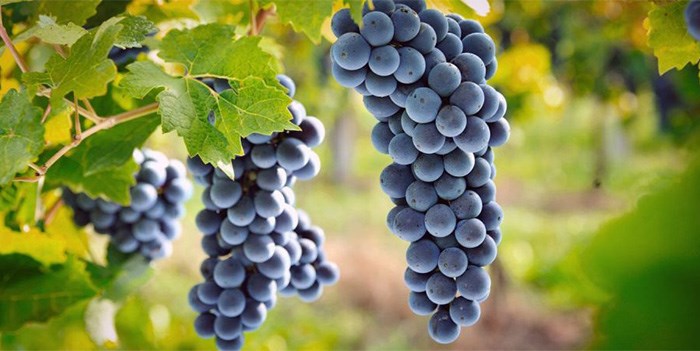 Photo: thewinecellarinsider.com
Photo: thewinecellarinsider.com
Why is Cabernet Sauvignon the king of red wine grapes? Ask Phylloxera. Or, maybe don’t.
If you ever met Phylloxera you’d punch him in the face. That situation won’t happen, the insect is far too small, but he sure is punch-ably nasty, and rather hard to kill because of the species’ ninja-like adaptability. In nymph form, he bores into a vine’s root, secreting a poison that prevents the plant from healing (thus killing the vine), and in winged form he travels to the next vine, the next vineyard, or the next town.
Native to North America, where he spent centuries trying to bore into the thicker roots of our own grape species Vitis Riparia (he still can’t because our winters made the roots too hardy), Phylloxera got his big jailbreak when he stowed away upon a cutting of Riparia that was commissioned by the Royal Botanical Gardens in England. I’m not sure if they were collecting the world's species because they were building some sort of Ark (if you’ve ever doubted the British habit of going everywhere and bringing back one of everything, I present to you: The British Museum), but I’m sure that they had no idea what they were about to do.
Phylloxera spread through Britain’s vineyards like a plague and took very little time spreading to the European mainland (at the time, 98% of the worlds wine came from Europe). The Euro species Vitis Vinifera (i.e. the grapes you make wine from) had never seen anything like this bug, and Phylloxera sliced through it like cheese. By the time they figured out that you could beat the louse by grafting Vinifera onto American rootstock, it was too late, nine tenths of Europe’s vineyards were destroyed. By the end of the 19th century, some wine regions had let a generation go by without being able to grow wine grapes.
And Port cities like Bordeaux were hit earliest and hardest. Fortunes were lost, farms were boarded up, vineyards lay fallow. Once Bordelais growers were able to replant, there was a palpable desperation to turn crops into dollars, pronto, so priority was given to those varieties that would make good wine, quickly. Where the pre-Phylloxera Bordeaux wines were a pretty even, pastoral mix of Carmenere, Malbec, Merlot, Cab Franc, Petit Verdot and the fledgling Cabernet Sauvignon (then an also-ran), the results-driven re-plantings were all about economics, and getting that wine train running on time again.
Being the somewhat recent child of the ancient Cabernet Franc and the white Sauvignon Blanc, Cabernet Sauvignon was only about 200 years old, and full of Hybrid Vigor (Heterosis), so the plants were hardier, healthier, and bent on growing. The variety also budded later in the season, after the potentially crop-destroying frosts, and the thick berry skins – besides contributing considerable tannins and flavours to the resulting wine – were unusually resistant to rot and other vineyard pests. For vignerons in Bordeaux’s Left Bank this was a no-brainer, and the variety quickly became the pragmatic, dominant grape there.
And all of this was happening in the early 20th century, as the eyes of the emerging New World wine regions turned to Bordeaux for inspiration and instruction. Fledgling winemakers from Argentina, America, Chile, Australia and South Africa were sent there to apprentice in the vineyards and cellars, and they returned home with state-of-the-art skills, and cuttings of this delicious, adaptable grape called Cabernet Sauvignon.
And unlike other varietal transplant attempts, Cab took to everywhere. As long as your growing region had a nice, warm autumn to accommodate its late-ripening tendencies, Cabernet Sauvignon would thrive there, and although the wines would certainly reflect your specific Terroir, the variety would remain distinctively itself; French Syrah and Australian Shiraz share identical genetics (they are the same grape) but very few characteristics, whereas Cab makes Cab wherever you grow it, albeit with telltale regional calling cards. Cabernet Sauvignon, due to its ease of cultivation, its longevity, and its transnational idiosyncrasy, became THE wine of the 20th Century, even eventually adopted by Old World regions like Tuscany and Catalonia.
But what about the 21st century? Speaking popularly, Merlot peaked and ebbed, as did Chardonnay (as will Malbec, mark my cryptic words), but Cabernet Sauvignon continues its steady climb, making both solid inexpensive juice and consciousness-changing premium wines. Pivoting between near-magical longevity and promiscuous drinkability, Cabernet Sauvignon is the core of many of the world’s cult wines, be they the classified growths of Left Bank Bordeaux, the silken body-bombs of Northern California, or the flagship wines of countless other regions, who vie for a seat at the grown-ups table by daring to produce the King Of Wines: Cabernet Sauvignon.
Written by Jordan Carrier, Vintage Room Consultant at Everything Wine – River District.


